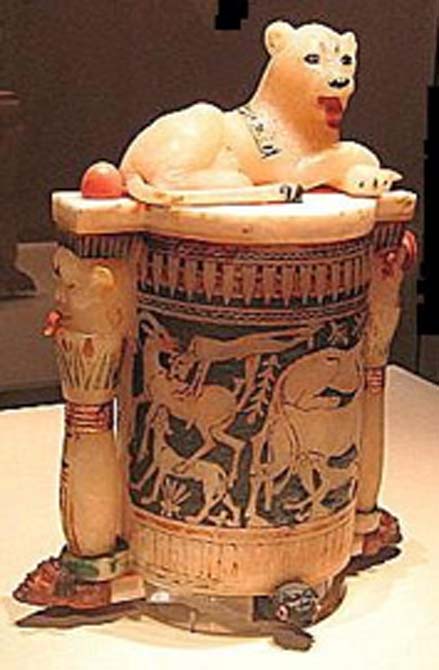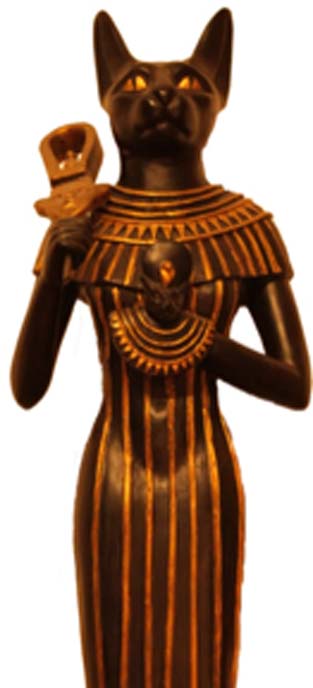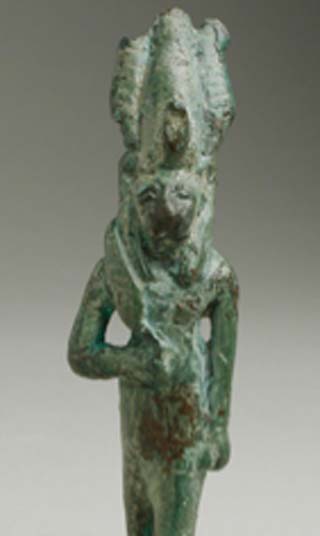
Egyptian Cat Goddess Bastet, Protector of the King
The wondrous world of Egyptian deities is filled with all manner of fantastic creatures, each one captivating in its unique depiction. This vast pantheon features hundreds upon hundreds of deities, many of whom are presented in an animal form – signifying the deep connection that the ancient Egyptians had with the nature around them. But one such deity stands out, and throughout history, the cult that surrounded it was one of the most prominent in Egypt.
Her name is Bastet, the cat goddess of love and passion, of joy, of women, of pleasure – of all things nice. Ferocious and sensual, this feline deity was loved through most of Egypt’s long history. And today we will truly get to know Bastet – in all her ancient splendor.

Bastet the Egyptian feline goddess. Source: malcapone / Adobe Stock.
From the Cradle of Egypt – The Earliest Form of Bastet
In ancient Egyptian mythology, Bastet was one of the several deities that held the title of the Eye of Ra. This signified her abilities as both a protector and an avenger. Bastet was known originally as Bast, and also Baast, Ubaste, and Baset, and she remains as one of the earliest attested Egyptian deities.
Her cult rose steadily throughout history and Bastet eventually became one of the chief goddesses in the pantheon, so much so that this deity had its center of worship in the city named after her – Bubastis. Bubastis was one of the more prominent ancient Egyptian cities, located in Lower Egypt, in the fertile Nile Delta.
The actual meaning of Bast’s name has long puzzled Egyptologists and researchers, as to what it truly represented. The hieroglyphic writing of her name - ![]() - meaning “bastt”, contains the hieroglyphs which portray an ointment jar and a loaf of bread beside it.
- meaning “bastt”, contains the hieroglyphs which portray an ointment jar and a loaf of bread beside it.

An 18 th dynasty burial artifact from the tomb of Tutankhamun, an alabaster cosmetic jar topped with a lioness representing Bastet. (83d40m / CC BY-SA 3.0)
The jar is known as “bas”, while the small half circle that portrays a loaf of bread denotes an ending –t, meaning bast. Most scholars agree that the correct translation of the name would be “She of the Ointment Jar” – since bas was the Egyptian heavy ceramic vessel that was used for storing perfumes and ointments – royal commodities of the time.
The most dominant role of Bastet is similar to some other feline goddesses – and that is protection of the king. Just like Mafdet, the feline protector of the pharaoh’s chambers, and the ferocious Sekhmet, the lioness who destroyed his enemies, Bast has been seen as the one who mothered the king and protected him.
The popularity of Bastet in ancient Egypt really rose to a high around the time of the 22nd dynasty, in 945 BC. At this time, Hedjkheperre Setepenre Shoshenq I, the founding pharaoh of that line made Bubastis his center, a major Egyptian town.
He began the work on constructing a splendid and magnificent temple, which was continued by his son Osorokon II, and finished by his grandson Osorokon III. The finished temple was dedicated to Bastet.
The earliest depictions of Bast were that of a female with a head of a lioness. This early image had a lot of parallels with the warrior goddess Sekhmet, who was also a leonine deity. But in time, the image of Bast became an increasingly docile one, and the image of a lioness shifted to that of a domesticated cat.
She was either represented as a woman with the slender, graceful head of a cat, or often as a cat without any human attributes. This in turn gave rise to the increased worship of cats in Egypt, which were held as revered and sacred animals.

Bastet represented as a woman with the head of a cat. (Kotofeij K. Bajun / CC BY-SA 3.0)
Throughout the entire history of ancient Egypt, cats held a very special place, and were given a very peculiar and special respect. Many other animals were revered and offered as mummified sacrifices to the gods – baboons, alligators, dogs, ibises, mongooses, and others – but none as much as the cats.
At a point in time, we can discern that reverence and the divinity of the cat was so widespread, that the actual reverence simply disappeared. The Egyptians focused on the divine aspect of the animal, i.e. Bast, but not the animal itself. That is why they mummified large quantities of cats as the means to appease Bastet.
In fact, the number of excavated cat mummies numbers in the millions. Another fact that signifies the gradual loss of reverence for cats is the fact that such sheer numbers of cats required for mummification grew into a lucrative economy for the Egyptian society. It grew into a vast trading network that covered the breeding and sale of cats, the sale of statues and burial coffins, the mummification officials, the food, the oils and resins for embalming, and all things connected.
Many necropolises dedicated exclusively to cats have been discovered, chiefly at Saqqara burial grounds (Memphis), in Bubastis, and Speos Artemidos near Beni Hasan. Each of these burial grounds held hundreds upon hundreds of thousands of mummified cats and elaborate cat coffins.
The Cat Worship – From Love to Meowmified Kitties
In 1890, a peculiar sight was documented by Sir William Martin Conway, 1st Baron Conway of Allington. While visiting Egypt, he witnessed the excavation of a large cat burial ground in Speos Artemidos, near Beni Hasan. There were more than 200,000 cats buried ina single field alone and the excavation was soon plundered by the locals.
- Chinese May Have Loved Cats before Ancient Egyptians
- Mummified Mice, Cats and Falcons Discovered In Long Lost Ancient Egyptian Tomb
- 8 of the Most Popular Animal Species in the Ancient World

Exhibit showing mummified cats at the Louvre Museum. (Netha Hussain / CC BY-SA 4.0)
They ravaged the site and picked out the finest mummies to sell to the passing tourists. At the time, you could buy an actual ancient Egyptian mummified cat for just a few coins. In fact, large shipments of these mummies were sent to England, especially Liverpool, where some were sold as souvenirs, while others were ground into fertilizer.
But even though these cats were culled on a large scale – with at least 10,000 cats mummified each year – they were nonetheless held in high regard, and unauthorized killing of a cat was a criminal offence of the highest rank. In fact, Diodorus Siculus wrote about a lynching of a Roman citizen in Egypt.
He killed a cat and was promptly lynched to death by an angry mob of Egyptian citizens. Harming a cat was a great insult. Likewise, the killing of an ibis, hawk, or a cat – whether accidental or on purpose – was punishable by death.
The worshipers of Bastet gathered each year for a sprawling festival in her honor. This is described in detail by Herodotus, who witnessed such a celebration. He writes that the Festival of Bastet was the most popular happening of the year, and that around 700,000 people would gather and sail down the Nile towards the city of Bubastis.
They would engage in lavish celebrations and consume more wine on that single occasion than throughout the rest of the year combined. Rituals and sacrifices were the culmination of the day, all done at the enormous temple of Bastet in Bubastis. And Herodotus mentions a large number of female worshippers at the festival, which leads us to the role of Bastet, which was increasingly prevalent at the time – her feminine role.

A priestess offers gifts of food and milk to the spirit of a cat. On an altar stands the mummy of the deceased. (P Aculeius / Public Domain)
Over time, Bast became increasingly differentiated from Sekhmet – who was a lioness, fierce and warlike. But the feline, cat form of Bast was much more docile, and in time this deity became the one of love, passion, sex, of women and motherhood, of cosmetics and joy, of fertility, dance, and healing. She was the gentler feline aspect, while Sekhmet was the fierce one.
Due to the fertility of domestic cats, Bast was connected to the similar function. And as the cats were graceful, coy, and friendly, so was Bast connected with sensuality, grace, and family. She was also one of the chief feminine deities, being the goddess of sex and pregnancy, of childbirth and motherhood.
Before the onset of the 22 nd dynasty of Egypt, her role was perhaps more dualistic. She had a double aspect – of a protective, nurturing mother, and that of a ferocious and vicious avenger. But her most prominent role was undoubtedly beneficent – the goddess of childbirth and childbearing. During the later Greco-Egyptian Period, this led to her being identified with the Greek goddess Artemis – a beneficial, kind protector, and a fearsome huntress.
She was also the protector of the household and was personified by the pet cat, which was often held in high esteem by the entire family. Once a pet cat would perish from old age, the entire family would descend into a period of profound grief. They would shave off their eyebrows as a sign of mourning and would be in such a sorrowful period until their eyebrows grew back.
The Leonine Mother
Bastet is also mentioned in the famous Pyramid Texts, in which she is invoked as the royal protector. It is written that the king’s mother and nurse are Bastet herself.
Throughout the Egyptian history, Bastet is also mentioned as being the mother of Maahes, a leonine male god, whom she conceived with the god Ptah. Maahes was the god of war and knives, known as the Wielder of the Knife, the Scarlet Lord, and the Lord of Slaughter. Like Sekhmet and early Bastet, he was portrayed as a man with a fearsome head of a lion.

Maahes with head of a lion wearing a crown and holding a knife. (Fæ / Public Domain)
At one time Bastet became so popular among the people of Egypt, that her cult spread to unnatural proportions. Pilgrims from all over Egypt traveled north towards Bubastis to pay their respects.
Once there they sought to purchase mummified cats which they would later offer as sacrifices to Bast. This gave rise to the incredible demand for cats, leading us back to the subject of cat mummification.
Thousands of cats were bred with the single purpose to be killed and mummified, but the number was not enough to meet the demand of worshipers. That is why many excavated mummies contain only fragments of cats, while some are completely empty. From this we can deduce that many of the priests and officials didn’t share the passion of the worshipers, and they tricked many into purchasing empty cat mummies.
But besides mummies, Bastet’s main portrayals stem from the many figurines, statues, carvings, and columns, usually made from bronze, which show the true form of Bast. The usual appearance on the figurines is one of a domestic cat – slender and graceful – surrounded by many kittens. Another usual depiction is of a cat seated on its haunches, decorated with jewelry.
- Discovery of high official tomb points to reuse of tombs and burial goods in ancient Egypt
- 1000s of Neolithic Engravings Reveal Egyptians' Ancient Reverence For Animals
- Discovery of mummified kestrel reveals evidence for falconry in ancient Egypt

Ancient Egyptian statue of Bastet after becoming represented as a domestic cat, between 664 and 610 BC. (Rama / CC BY-SA 3.0)
This corresponds with Herodotus’ writings of house cats in Egypt which were adorned with earrings and gold jewelry. Herodotus also writes that each cat had its own guardian, a person who took care of it, and considered it a great honor.
But from a logical point of view, the worship of a feline deity has some easily explained reasons behind it. At a time in Egypt’s history when food stores were under constant threat from mice, rats, and similar rodents, as well as from cobras, a cat which naturally killed them was seen as a protective animal.
There is no doubt that to some extent the belief of ancient Egyptians was largely primitive in a way and centered on the nature around them and their role within it. The fertile Nile Delta teemed with life of all sorts and its inhabitants learned to worship both the protective and the hostile beasts that dwelt beside them.
Cats Representing Bastet Were Loved to Death
Bastet was undoubtedly one of the most popular and loved deities in the entire history of ancient Egypt. Her worship is second only to the great gods such as Ra, Seth, Osiris, Thoth, or Ptah. And we can understand why it was so.
Personified as a cat woman, sensual and graceful, but also ferocious and unpredictable, she was both loved and respected. And being a central part of everyday Egyptian life, she was considered as a central part of their society – integrated into all occurrences.
Yet, we can all agree that the popularity of Bastet didn’t reflect so well on the domestic cats of ancient Egypt. For such was the love of the worshipers of Bast – cruel and unreserved.
Top image: Goddess of Egypt, Bastet. Credit: MiaStendal / Adobe Stock
References
Cass, S. 2003. All About Bast. [Online] Available at: http://www.per-bast.org/bast/historical.html
Engels, D. 1999. Classical Cats – The Rise and Fall of the Sacred Cat. Routledge.
Hart, G. 2000. A Dictionary of Egyptian Gods and Goddesses. Routledge.
Ikram, S. 2005. Divine Creatures – Animal Mummies in Ancient Egypt. The American University in Cairo Press.
Markoe, G. and Capel, A. 1996. Mistress of the House, Mistress of Heaven – Women in Ancient Egypt. Hudson Hills Press.
Pinch, G. 2002. Handbook of Egyptian Mythology. ABC-Clio.
Trumble, K. 1996. Cat Mummies. Scholastic Inc.















Comments
Identifying Bastet with Artemis must have caused some problems for the Greeks as Bastet was supposedly married to Ptah, while Artemis was a virgin goddess